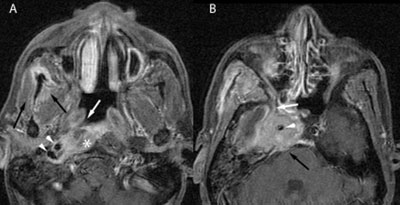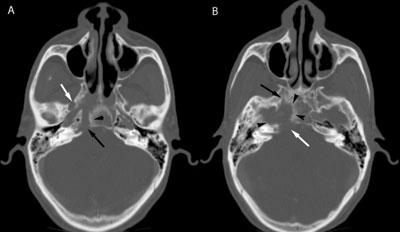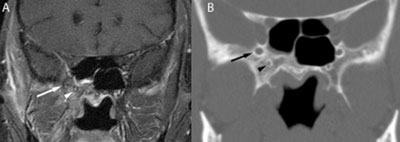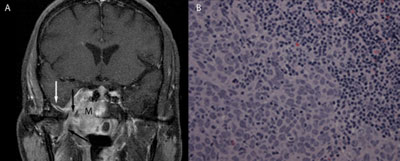Nasopharyngeal carcinoma in an HIV-positive patient with cranial nerve defects
A 48-year-old black man with a history of chronic hepatitis C and HIV, well controlled on highly active antiretroviral therapy, presented with a 3-month history of throbbing, intermittent right eye pain.
His pain would not subside with acetaminophen, and he started having double vision, which was exacerbated when he looked to his right side. He also reported hearing loss, primarily on the right side, and numbness in the right part of his face.
Upon presentation, his physical exam was significant for horizontal diplopia with rightward gaze, which was worse at distance. There also was left eye nystagmus with the fast component to the left with a right gaze. In addition, he had decreased sensation in the right mandibular area and in the right ophthalmic nerve distribution of the periorbital region.

Figure 1. A) An axial post-contrast, fat-saturated T1 image, in keeping with origin from the posterosuperior aspect of the nasopharynx, shows the enhancing right nasopharyngeal mass is relatively sparing the right fossa of Rosenmüller (white arrow). There is posterolateral extension into the right longus capitis muscle (asterisk), indicating violation of the prevertebral fascia. Contiguous disease is resulting in encasement of the internal carotid artery and jugular vein just below the skull base (arrowheads). There is mild enhancement of the right temporalis and masseter muscles (black arrows), consistent with subacute denervation atrophy secondary to tumoral involvement of the mandibular nerve. B) Slightly craniad to image A, there is an enhancing mass centered in the right cavernous sinus, with anterior extension into the right foramen rotundum (white arrow). The cavernous carotid artery is encased and narrowed (arrowhead). There is posterior erosion through the clivus into the prepontine cistern (black arrow).
Source: Images courtesy of M. Ghesani, MD, reprinted with permission.
A noncontrast head CT demonstrated prominence of the right nasopharyngeal soft tissues. Given the patient’s history of HIV, further imaging was performed with a contrast-enhanced MRI of the brain and orbits. The MRI demonstrated a large, irregular enhancing mass centered at the superior aspect of the right nasopharynx, best seen on the axial and coronal post-contrast T1-weighted images (Figure 1).
There was relative sparing of the right lateral nasopharyngeal recess (fossa of Rosenmüller), but there was posterolateral extension to involve the carotid sheath. There was destruction of the right clivus and right petrous apex, as well as portions of the sphenoid bone. The mass extended posteriorly to involve the right jugular foramen and hypoglossal canal, and extended into the right prepontine cistern. There was extensive involvement of the right cavernous sinus, with encasement of the cavernous carotid artery (Figure 1B).

Figure 2. A) An axial CT image shows abnormal widening and erosion of the foramen lacerum (black arrow), with abnormal sclerotic change in the adjacent petrous apex (asterisk) and basisphenoid (arrowhead). There also is abnormal widening of the right foramen ovale (white arrow). B) Slightly craniad to image A, there is more extensive peripheral bone destruction centered above the foramen lacerum involving the carotid canal (arrowheads). There is involvement of the posterior aspect of the vidian canal (black arrow), and there is erosion into the posterior cranial fossa (white arrow).
Subsequently, a contrast-enhanced CT of the neck was performed to assess the inferior extent of the mass. No pathologically enlarged cervical lymph nodes were noted within the soft tissues, and the airway was patent. However, the CT was able to demonstrate the extensive bony involvement more clearly (Figure 2).
The mass was biopsied and pathology showed nasopharyngeal carcinoma, primarily non-keratinizing type (Figure 3B). A fiberoptic nasolaryngoscopy again showed a yellowish friable mass in the posterior nasopharynx that did not cross the midline.
Nasopharyngeal carcinoma
Nasopharyngeal carcinoma (NPCA) is the most common cancer of the nasopharynx. About 80,000 cases develop annually, but incidence is declining for reasons that are unclear.
NPCA has a unique geographic distribution, being endemic in southern China (Guangdong province) and rare in the United States and Western Europe. Factors that contribute to its endemic nature include genetic predisposition and carcinogens (nitrosamines) in food eaten as a child. It is 2.5 times more common in men than women. Peak ages of incidence are 15 to 25 years, and 50 to 60 years.
Patients typically present with headaches and a painless mass in the neck due to cervical node metastasis. When any of the three divisions of the trigeminal nerve are involved, NPCA can present as facial hyperesthesia.
Neurologic symptoms, as seen in our patient, occur in 25% of the cases. They often are due to cavernous sinus extension and involvement of cranial nerves. The cavernous sinus is a passageway for multiple structures, including cranial nerves (III, IV, V1, V2 and VI) and the internal carotid artery.
The primary lesion is variable in size at presentation. MRI and CT may have complementary roles in mapping out the borders of the tumor and delineating the extent of skull base invasion, when present. PET or integrated PET/CT helps to detect distant lymph node involvement and bone metastasis.
NPCA may arise from the posterosuperior aspect of the nasopharyngeal mucosal space, as in this case, although this is less common than origin from the lateral nasopharynx. When NPCA arises from the posterosuperior wall of the nasopharynx, it may spare the fossa of Rosenmüller, an area that is usually involved when the tumor arises in the lateral nasopharynx.
Superior extension into the central skull base is well known, and the cartilaginous foramen lacerum is a common entry point for tumor, whether arising from the lateral or posterosuperior nasopharynx. In this case, the patient presented with advanced stage of tumor growth, with intracranial extension through the region of foramen lacerum into the overlying cavernous sinus. There also was posterior extension into the prevertebral space involving the longus capitis muscle, as well as the carotid space structures below the skull base (Figure 1A).
Perineural tumor spread (PNS) in the head and neck most commonly occurs centripetally, extending intracranially from a primary tumor in the deep tissues of the neck or face. However, tumors also may extend away from the brain along neural pathways, known as centrifugal PNS. For example, once there is a tumor in the trigeminal ganglion, it may extend out of the skull through the neurovascular foramina that carry the other divisions of the trigeminal nerve. For PNS in general, contrast-enhanced MRI is more sensitive than CT, as it will reveal abnormal signals in the involved nerves before osseous changes in the surrounding canal are evident on CT (Figure 3).

Figure 3. A) A coronal post-contrast, fat-saturated T1 image shows asymmetric enlargement and enhancement of the right foramen rotundum (white arrow) and right vidian canal (white arrowhead), consistent with the presence of a tumor. B) A coronal CT image shows the anterior aspect of the vidian canal (arrowhead) appears normal at the level of the orbital apex. The right foramen rotundum (black arrow) is subtly enlarged compared with the normal left side, but it has an intact normal sclerotic border.
Case specifics
In this case, disease in the foramen rotundum (Figure 3) may be due to direct tumor growth from the contiguous disease in the right paracentral skull base. However, it may represent centrifugal PNS from the tumor in the cavernous sinus.
Disease in foramen ovale (Figure 4A) most likely is due to centrifugal PNS — because foramen ovale is on the periphery of the tumor’s path of growth through the skull base — and less likely to have been involved by direct contiguous tumor spread from the nasopharynx (Figure 2). Presumably, the tumor extended from the cavernous sinus to the trigeminal ganglion in Meckel’s cave. There is associated subacute denervation atrophy of the muscles of mastication.

Figure 4. A) A large enhancing mass (M) has extended superiorly from the roof of the nasopharynx into the right cavernous sinus, traversing the right central skull base. There is a tumor widening the foramen ovale and extending along the mandibular nerve into the right masticator space (black arrows). There is extension along the dura of the floor of the right middle cranial fossa (white arrow). B) The nasopharyngeal biopsy shows a cohesive sheet of malignant cells showing prominent nucleoli, nuclear pleomorphism and high nuclear to cytoplasmic (N/C) ratio, in a background of lymphocytic infiltrate (haematoxylin and eosin, 400 times).
There also is erosion of the posterior aspect of the vidian canal, most likely directly from the adjacent disease at foramen lacerum (Figure 2B). Involvement of the vidian canal raises the possibility of PNS along the greater superficial petrosal nerve, a branch of cranial nerve VII. However, PNS also may occur between cranial nerves V and VII due to the direct physical proximity of the greater superficial petrosal nerve to Meckel’s cave. A more common pathway for PNS between cranial nerves V and VII is from their connections at the pterygopalatine ganglion. However, in this case, the pterygopalatine fossa did not appear to be involved.
Staging and treatment
WHO categorizes NPCA in the following ways: type I, keratinizing squamous cell carcinoma; type II, non-keratinizing carcinoma; and type III, undifferentiated carcinoma.
Type I, the least common form, is associated with tobacco and alcohol use. There also is evidence of association of type I with HPV infection. Types II and III are considered to be on a spectrum of the same disease, and these have a strong association with prior Epstein-Barr virus infection. Epstein-Barr virus titers are prognostic of disease, with the cutoff being 1,500 copies/mL, and can be used as marker for response to therapy. Persistently elevated titers 1 week after completion of therapy are associated with poorer OS. Our patient was found positive for Epstein-Barr virus in the serum, and his initial titers were more than 4,000 copies/mL.
Staging of NPCA is clinical and is based on the American Joint Committee on Cancer tumor– node–metastasis staging system, which assesses a tumor according to its extension to adjacent structures, its lymph node involvement and the presence of distant metastasis.
In our case, the patient presented with no significantly enlarged cervical lymph nodes. Metastatic spread is very common. Lymph node metastases are present in 75% to 90% at diagnosis, and distant metastases are found at initial diagnosis in 5% to 10% of cases. Common metastatic sites are the bone, lung, liver and distant metastatic nodes.
Chemotherapy and radiation typically are used for treatment if type I NPCA. Type II and III NPCAs are very radiosensitive, and early-stage (T1) disease can be treated with radiotherapy alone, with a 5-year OS of 90%. For more advanced disease, platinum-based chemotherapy and concurrent radiation therapy is used. Of the available treatment options, it seems that combined chemoradiotherapy reduces distant failure better than induction chemotherapy or adjuvant chemotherapy.
References:
Caponigro F. Anticancer Drugs. 2010:21:471-477.
Chan AT. Ann Oncol. 2009;20 Suppl 4:123-125.
Goh J. Ann Acad Med Singapore. 2009;38:809-816.
Stambuk HE. AJNR Am J Neuroradiol. 2005;26:1575-1579.
For more information:
Munir Ghesani, MD, is an attending radiologist at St. Luke’s-Roosevelt Hospital Center and Beth Israel Medical Center, an associate clinical professor of radiology at Columbia University College of Physicians and Surgeons, and a HemOnc Today section editor. He may be reached at Department of Radiology, Beth Israel Medical Center, First Avenue at 16th Street, New York, NY 10003; email: mghesani@chpnet.org.
Grigorios Chrysofakis, MD, is a fellow in hematology/oncology at St. Luke’s-Roosevelt Hospital Center.
Michael Chung, MD, is a radiology resident at St Luke’s-Roosevelt Hospital Center.
Daniel Meltzer, MD, is an assistant attending physician in radiology at St Luke’s-Roosevelt Hospital Center and Beth Israel Medical Center. He also is assistant professor of clinical radiology at Albert Einstein College of Medicine.
Ippolito Modica, MD, is an anatomic and clinical pathologist at St. Luke’s-Roosevelt Hospital Center.
